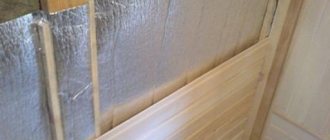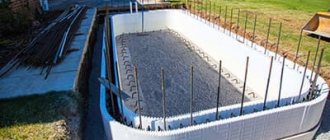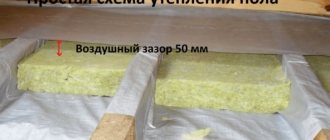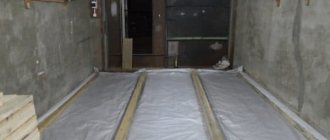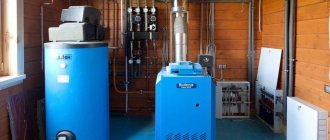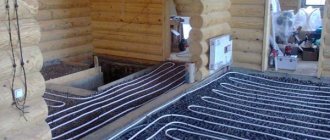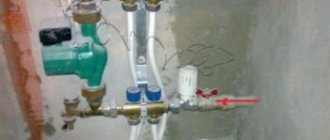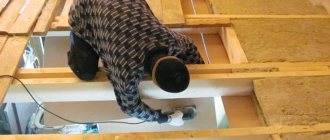When building a house, it is necessary to provide measures for heat - air - steam - waterproofing. If modern materials are used for insulation, then all kinds of films and membranes are a given, which cannot be avoided.
It’s easy to learn how to work with them: instructions for use always accompany the packaging. This is the law. References to houses that have stood for 200 years without any insulation are not accepted.
Human physical contact with building structures is limited to one type: floor. Its temperature determines the comfort in the room.
Floor insulation with polystyrene foam
If you chose the first method, then you should lay wooden blocks - logs - on the leveled and cleaned concrete screed, maintaining an interval between them equal to the width of the selected insulation.
The lags are fastened with anchors or self-tapping screws on steel corners; their leveling is done using wooden spacers. Calculation of the height of the upper plane of the block above the floor looks like this: insulation thickness + 50 mm clearance for ventilation. Advice. When concrete floors are insulated with mineral or basalt materials, it is better to make the distance between the joists less than the width of the insulation by 1 cm so that the insulation fits there as tightly as possible. For expanded polystyrene boards, the interval should be made smaller by a couple of millimeters for the same purpose.
Now let’s talk about how to properly install the insulation. First, waterproofing is laid from a dense polyethylene film with an overlap of 100 mm between the sheets and the joints are taped. Then the thermal insulation slabs are laid. On top they are again covered with a vapor barrier film so that moisture from the premises does not penetrate into the insulation.
Advice. Contrary to popular belief, polystyrene foam absorbs moisture, although in very small proportions. Therefore, protective films on both sides of the insulation are always needed when using any materials, especially cotton wool and polystyrene foam. This will significantly extend their service life.
Penofol is often used instead of film; it allows you to reduce the layer of the main insulator and protect it from moisture. The joints are also taped, only with foil tape. This completes the insulation of the concrete floor; you can lay the coating and laminate or linoleum.
For reference. The thickness of the cement screed should be in the range from 50 to 80 mm. The optimal option, taking into account different loads on the floors of a living space, is 70 mm.
When it comes to a wooden house, it should be taken into account that such structures can be slightly deformed because the wood “breathes”. This is almost unnoticeable in an old house, but in a newly built one, concrete floor coverings can crack if damping is not provided. To do this, a thin layer of polystyrene (up to 15 mm) is laid along the entire perimeter along the walls, even before work begins, as shown in the photo:
Subfloor of the second floor (attic) or cold attic
There are no living rooms under the wooden floor of the first floor, so “simple” materials can be used for lining without finishing or decorative surface treatment. The interfloor ceiling is hemmed from below with planed boards or clapboard.
And although insulation of the floor between heated floors is not required, mineral wool is placed between the joists. In this flooring pie it acts as sound insulation. Ideally, you should use acoustic wool. It differs from the usual one in its “chaotic” fibrous structure. But heat-insulating modifications can also be laid - with the same thickness and density, their sound absorption coefficient is only 10-15% lower than that of acoustic ones.
The ceiling of a cold attic must be insulated.
Installation of a cold attic ceiling begins with attaching a vapor barrier Source legkovmeste.ru
And since in a low-rise building even an “uninhabited” attic is used, the insulation must be covered with a subfloor (but without further finishing).
The ceiling diagram of a cold attic looks like this (from bottom to top):
- false ceiling of the underlying heated floor;
- vapor barrier laid in a continuous and continuous layer with sealing tape along the entire perimeter of the ceiling;
- insulation between beams (lag);
- membrane-type waterproofing laid on the surface of stone wool;
- spacer bar stuffed onto the beams, providing a ventilation gap;
- attic subfloor.
Important! The layer-by-layer structure does not reflect the installation sequence. At the first stage, a vapor barrier film is attached to the bottom of the floor beams. And on top of it, a block is mounted on the beams, to which the sheathing for the false ceiling is attached. If you first hem the boards, the film will have to be laid on top of the beams. In this case, water vapor will penetrate into the wood, but there will be nowhere for it to erode, which will lead to wetness of the floor beams and create conditions for their rotting.
Water heated floor system
Such a system is performed in the following sequence:
The base of the floor is poured (cement screed) or concrete slabs are laid. Any insulation can be installed; its thickness can be from two to ten centimeters.
Reinforcement mesh is laid. The pipeline system is being installed. It is attached with plastic clamps to the reinforcing mesh.
The floor is filled with suitable materials (flooded floor system). A substrate is used if necessary. Finish floor coverings are being laid.
Electric “warm floors” in a wooden house
It is much easier to make electric heated floors. You can use cable structures or film heating elements. In this case, the cable can be stretched on a metal mesh attached to the joists.
If infrared film materials are used, they can be laid directly on the screed protected by thermal insulation materials.

The variety of thermal insulation materials on the modern construction market often leads buyers to a dead end. To choose the right material, you need to know its features and possibilities of use.
Insulate.
This is a thermal insulation material in rolls made in China. The quality of the material is quite high at a low price. The insulation is suitable for thermal insulation of any structures.
Ursa
One of the most popular thermal insulation materials. This material is more often used for horizontal surfaces. It has a low price, excellent thermal insulation and sound insulation qualities.
Thermolife
Used for light loads on thermal insulation. It is most often used for insulating walls, roofs, ceilings, and interfloor spaces. Can be used on horizontal, vertical and inclined surfaces.
No less popular are thermal insulation materials such as:
Rockwool, Isolite, Isovent, Teplex, Penoplex and many other types of thermal insulation
It is important to make the right choice for your wooden house

Insulating the house from the inside
Insulating a house that does not yet have any interior decoration is much easier than doing it in a house that is already fully furnished and landscaped.
There is no need to rush into any interior work until every room in the house is properly insulated. Thanks to modern materials, you can do this yourself. Any room will be cozy and comfortable if you approach the matter competently and carefully read the technology for insulating the ceiling, walls and floor.
As a rule, ceiling insulation is not treated responsibly.
Many people believe that there is no need to insulate it, but this is far from true. The air that people try so hard to heat in winter rises up and goes through the ceiling to the street. Making a serious mistake - leaving the ceiling uninsulated, many people unknowingly lose half the heat, they senselessly spend money on heat that goes into the unknown.
Ceiling insulation material:
For the construction and covering of the frame you will need:
Tools for ceiling insulation:
Stages of ceiling insulation:
We make a frame from an edged board; you need to be prepared for the fact that this will reduce the height of the room. The distance between the frame boards should be no more than 1 meter. Glassine must be glued between the frame boards, leaving no empty spaces, so that the material holds well, it needs to be coated a little with tile adhesive. We lay insulation on top of the glassine - mineral wool.
Do not leave holes between the insulation. If the material does not hold, use tile adhesive in small quantities. The last step is covering the ceiling with plasterboard. Using a screwdriver, screw the sheets of drywall to the wooden frame.
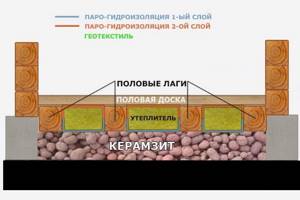
Methods for insulating a concrete floor
Whether in finished slabs or when pouring a monolith, thermal insulation materials are not used in the floor pie. Insulation is combined with leveling, placing the base under the finishing layer. There are several main ways.
Floating screed
- Waterproofing is laid on the concrete - a film of 200 microns or a specialized membrane, if the pieces are joined, the overlap is 10-15 cm, the joints are taped, and 10-15 cm is also placed on the wall.
- The perimeter walls are separated with damper tape - a ready-made or homemade tape made of polyethylene foam, usually glued to the wall with “liquid nails” or a similar composition. The recommended thickness of the damper tape is 10 mm, so that there is a margin for compression, since the dimensions of the screed will change (shrinkage, operation).
- A specialized slab insulation, designed for use in loaded structures, is laid on the waterproofing.
- On top of the insulation is another layer of waterproofing in the same way, but without putting it on the walls.
- Pouring the screed - when preparing the solution, it is important to add porous fillers instead of part of the sand: perlite or polystyrene foam granules. Such replacement will increase the porosity of the screed and reduce its thermal conductivity, the surface will not feel so cold. To prevent cracking, fiber fiber is also added to the solution; it replaces mesh reinforcement.
- Finishing - if the final coating requires a perfectly level base, it may be necessary to use a self-leveling thin-layer mixture for leveling. In other cases, minor differences in the surface are compensated by either the substrate or the adhesive layer.
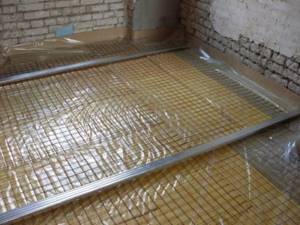
Dry screed
- Waterproofing is laid on the concrete, as with a floating screed.
- A damper tape is fixed around the perimeter.
- Thermal insulation slabs are laid.
- To maintain the level, use a laser level or a hydraulic level; beacons are placed along it; galvanized profiles for gypsum boards are more convenient.
- Backfilling - instead of mortar, a compacted layer of fine-grained composite insulation is laid on top of the insulation along the beacons, usually expanded clay, but variations are possible (perlite, slag, slag pumice, etc.). After backfilling, the beacons must be removed. In regions with a relatively warm climate in dry screed systems, you can refuse to use thermal insulation and lay the filler directly on the waterproofing.
- Various sheet materials are used as a rough coating on top of a dry screed, most often it is ordinary and moisture-resistant plasterboard, but it can also be plywood, DSP, chipboard or OSB. The coating is laid in two layers with overlapping joints. Some manufacturers immediately produce dry screed systems, including both filler and sheets of drywall with a ready-made mounting groove.
Dry screed can also be used to insulate a wooden floor over a subfloor, if the ceiling height allows, but instead of waterproofing, bitumen paper is laid on the wooden base.
Insulation by joists
- Waterproofing is laid over the concrete.
- Wooden logs are installed on top, the pitch depends on the type of insulation used.
- Insulation is laid/filled between the joists.
- A vapor barrier membrane is laid on top of the insulation.
- If necessary, lay rough flooring from boards or slab materials or immediately finish the flooring.
As in the situation with insulation of a wooden floor along joists, there must be a gap between the insulation and the flooring for ventilation. If there is no gap left after laying or backfilling, a backing beam is placed on top of the vapor barrier.
Briefly about the main thing
If you don’t know how to install a vapor barrier on the floor of a wooden house correctly, you can find out within a couple of years that it has begun to rot, and the insulation has gotten wet and stopped working. The main rule is not to use impenetrable films that are prone to condensation accumulation for vapor barrier of wooden structures. The material must retain excess moisture and gradually evaporate it. Special films and membranes have these properties, some of which are intended for indoor use, others for outdoor use.
During installation, it is important to take into account that such materials are double-sided and to lay them correctly
Source
General operating principles
The technology in question is quite common in private construction. Moreover, I did both floor insulation in a wooden house using joists, and thermal insulation of the floor covering in a city apartment using a similar technology. Its advantage is that there is no need to carefully level the base using a screed or self-leveling mixture.
Moreover, today I will tell you how I insulated the floor without preparing the base at all, since the subfloor was built on the ground.
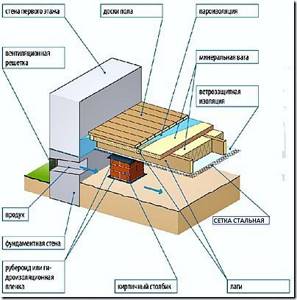
General diagram of the insulating pie
Be that as it may, the work scheme is generally the same and consists of several points:
- dismantling old flooring;
- installation, repair or preparation of the base of a future insulated floor;
- thermal insulation of horizontal surfaces;
- hydro- and vapor barrier insulation;
- installation of finished floor covering.
Before moving on to a more detailed description of the technology, I want to dwell a little on what insulation to use in the work.
Note to builders
- Penoplex and teplex are products of progressive techniques created on the basis of extruded polystyrene. The base for the teplex was a foamy “cocktail” of ozone and freons. Innovative materials are highly effective as a heat insulator and have no disadvantages.
- Isoven and isolight confirm the best quality properties of rocks.
- Ursa is a type of mineral wool.
- Insulation - this option is similar in properties to the previous type. The basis is staple fabric, and the cost is half the price of the above-mentioned heat insulators.
- Thermolife is a processed stone wool based on basalt rocks.
The incoming cold air from the underground affects the blackness of the walls and the dampness of the air. There are two ways to get rid of such problems: carry out work on insulating the subfloor directly on the ground or install logs. But the problem should be solved, starting with the first action, which requires making the necessary thermal calculations.
Material requirements
The following materials are usually chosen for flooring :
- edged board;
- waterproof plywood;
- Fiberboard or chipboard with waterproof treatment;
- OSB plate;
- cement particle board (CSB) or GVL.

Plywood is stronger due to its multi-layer structure, and it is much thinner for a subfloor.
Floor insulation technology
It is important to lay the insulation correctly, observing the correct order of all layers. The floor pie when insulating the attic floor, the floor of the second floor or the first has not always noticeable, but significant differences
Insulation of the floor of the first floor from below
In this case, when carrying out work with your own hands, the materials should be correctly laid in the following order:
- waterproofing;
- insulation;
- vapor barrier;
- ceiling design.
When building a house from timber or frame, the material is secured along the beams. After which the filing is performed. As a protection against moisture and steam, you can use ordinary polyethylene film. As a second option for waterproofing, moisture-proof membranes are used. If all layers are laid correctly, the structure will be reliably and competently protected from the cold from the point of view of heating engineering.
Also, for insulation from below, the method of insulating the ceiling with foam is perfect.
- vapor barrier;
- insulation;
- waterproofing;
- beam-based floor structure.
Insulating the attic floor
- ease of installation;
- the possibility of using inexpensive bulk materials;
- competent thermal protection;
- insulation of not only the room, but also the ceiling along the beams of a house made of timber or frame;
- prevention of condensation in the thickness of the ceiling.
To ensure proper protection, the layers are laid in the following order from bottom to top:
- floor design;
- vapor barrier;
- thermal insulation material;
- waterproofing.
For waterproofing, a plastic film will be sufficient, but as a second, more serious option, you can use roofing felt. When building a house from timber or during frame construction, you can also read the article “Insulating the attic floor using wooden beams.”
Insulation of the ground floor floor from the inside
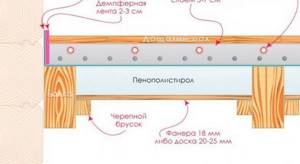
Carrying out work under the ceiling is quite inconvenient, therefore, when constructing a frame house or a building made of timber, insulation of the first floor ceiling is often carried out using beams from above. In this case, in addition to the previously mentioned materials, you can use bulk materials such as sawdust and expanded clay. When carrying out insulation with your own hands, correctly lay all layers in the following sequence:
- floor design;
- waterproofing;
- insulation;
- vapor barrier;
- clean floor.
Insulation of interfloor ceilings

In the first case, the insulation dampens airborne noise: human speech, music, etc. In the second case, the structure is also perfectly insulated from impact noise - steps, jumps, etc.
Which floors require insulation?
The following structures need protection:
- cold basement floor pie;
- attic floor;
- interfloor slab design.
In the case of an interfloor option, the material is used as sound insulation. In this case, you need to provide a layer 3-5 cm thick.
Insulating the floor of the first floor in a wooden house allows you to provide comfortable living conditions. Most heat loss occurs through the ceiling of the upper floor, so it is necessary that the insulation is selected and installed correctly.
Technology and features of floor insulation from below in a wooden house
For each type of insulation, there are some specific features of use.
Mineral wool
The sizes of rolls and slabs are usually multiples of 60 cm, which makes this distance the optimal step between the logs. Mineral wool is cut to size with a cutter and placed in the space between the joists. For a tight fit, the size should be 1–2 cm larger than the distance between the joists. Cotton wool should not be pressed down forcefully as this may affect its characteristics.
The best option would be to lay two layers of insulation. The second layer is laid so that the joint of the lower layer falls on the center of the upper piece. This method of installation will prevent cold air from entering the room.
How to insulate floors along joists
Insulation of floors in rooms located on the ground floors has its own characteristics depending on the type of structures, their installation scheme, the purpose of the underlying space - a full basement of a heated or unheated type, a basement, a technical underground, closed or open (on stilts, brick or concrete pillars ) type.
Beamless floor slab
The beamless floor of the lower floor, using a soil foundation as a base, can be constructed in a concrete version. This can be a monolithic concrete slab reinforced with mesh, cast directly on site, with waterproofing between the ground and concrete from several layers of some rolled roofing felt material or geotextile.
On top of the concrete slab, in increments of 40...60 centimeters, logs are installed - beams with a thickness of more than 75 mm, and a height that ensures that heat-insulating material of the required thickness is laid between them. The logs are fixed with self-tapping screws on dowels, corners bent from tin, and wooden shorts.
Joists on top of a concrete precast floor
Beam floor of the lower floor
The beam floor is arranged in the same way as the interfloor floor, with the exception of the lower cladding along the cranial beams, the functions of which are performed by the soil foundation. The ends of load-bearing beams made of rolled metal profiles (angle, channel, I-beam) or wooden edged and unedged logs of the required span and section are embedded in the load-bearing (main) walls of the house at a distance of at least 10 centimeters.
On top of the beams, beams-logs are installed perpendicular to them. The smaller the lag pitch, the smaller their cross-section can be. The free space not occupied by beams and joists is filled with heat-insulating material, leaving a ventilation gap 2...6 centimeters high with the lower plane of the floor covering.
Video description
You can see the stages of floor insulation with mineral wool along joists in the video:
If there is a basement below
Insulating the floor on the ground floor involves laying insulating material between the floor and the basement - in multi-storey buildings, cold air flows take in heat from the lower floors, thereby cooling the rooms. However, a nuance of insulation on the first floor with a basement is the need for a powerful moisture insulation system in front of the heat-saving layer. The most commonly used polyethylene film is 150 microns.

Wooden flooring - most often parquet - has low thermal conductivity, which makes it an ideal flooring for the first floor. Alternatively, you can use chipboard or pure wood in the form of boards and beams.
Penoplex and foam plastic
If foam plastic is used when insulating a wooden floor from below in a private house, you must take into account several rules for working with it:
- Foam absorbs water, so waterproofing is required. Many experts do not take this property into account during installation, which leads to a decrease in thermal insulation characteristics.
- It is recommended to cut the sheets not exactly to the size of the gap between the joists, but 1–2 cm smaller. This will allow you to fill the gaps between the sheet and the joist with polyurethane foam, which will increase the thermal insulation properties. The joints between the sheets also need to be foamed.
Sheets can be fastened using slats, spacer wedges or special adhesives.
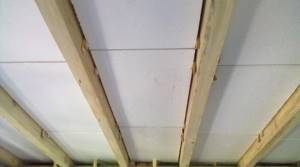
Floor insulation with foam plastic in a wooden houseSource sk-amigo.ru
The principle of working with penoplex is no different. But due to the smaller thickness of the material, it can be laid with overlapping sheet joints to avoid the formation of cold islands (similar to mineral wool).
But this method significantly increases material consumption, which means additional financial costs.
Penofol
Due to its property of not allowing moisture to pass through, penofol does not require additional installation of vapor and waterproofing. But to prevent the water vapor that forms in the room from settling on the insulation layer, an air gap is needed between it and the flooring for air circulation.
Laying is done with the foil side up only. This will allow heat to be reflected, which will increase the temperature in the house. Penofol can be used as waterproofing when laying mineral wool or polystyrene foam. This can increase thermal insulation several times, but this method is quite expensive.
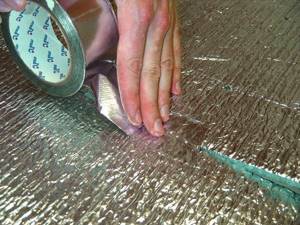
Penofol joints are sealed with adhesive tapeSource build.4-u.info
The material is sold in rolls and can be easily cut into pieces of the desired size. Fastening is carried out with a construction stapler on staples or with thin slats that are nailed. To improve the result, it is recommended to lay penofol in several layers.
One of the main problems of wooden houses is cold floors, which interfere with a comfortable life and increase heating costs. Proper insulation will solve this problem. Regardless of the material that is chosen for insulating the finished floor in a wooden house from below, it is necessary to strictly follow the general technology and procedure for insulation, as well as take into account the features of a particular insulation. The cost of installing insulation pays off within one season.
Step-by-step installation of a floor on a pile foundation
Let us describe the sequence of actions for arranging and insulating the floor of a frame on screw piles. Work begins after careful preparation of the wooden elements: treatment with an antiseptic and fire retardant compound.
Strapping device and lathing fastening
Let's assume that the piles are installed and the metal heads for fixing the beams are secured. Further progress of work:
- Drill four holes on each “bottom” of the screw supports.
- Lay waterproofing, for example, roofing felt, on the heads.
- Lay out the beams along the perimeter of the structure and connect the elements together “in half a tree.”
- Attach the beams to the heads with self-tapping screws.
- Insert the remaining beams inside the perimeter.
- Use steel staples to additionally connect the strapping parts.
- Check the horizontal placement of the beams.
- Fill the bottom of the beams with sheathing - a base for attaching the substructure.
Rough base and thermal insulation
Lay sheets of OSB, chipboard or moisture-resistant plywood on top of the guide rails. If edged boards are used, they must be nailed perpendicular to the joists.
After preparing the subfloor, they begin to insulate it:
- Cover the base with waterproofing film.
- Place insulation in the cells between the joists. When cutting mineral wool, it is necessary to provide a margin of 0.5 cm on each side for the tightest possible fit and to prevent the appearance of cold bridges.
- Spread a vapor barrier membrane over the insulation with an overlap between the sheets. Tape the joints with construction tape.
The next steps depend on the type of floor covering.
Creating a thermal contour for the plinth
The installation of a floor in a house on stilts necessarily involves driving in the base. The following methods of insulating finishing are possible:
- Brickwork. The base is a cushion of crushed stone and sand. The fence is laid out in half a brick; reinforcement is not necessary. Ceramic or clinker bricks are used for work.
- Siding. Thermal plates are mounted on a lathing made of galvanized profiles or bars, assembled on piles.
- Profiled sheeting. Purlins are welded to the bored posts, which serve as the basis for attaching the profiled sheet.
- DSP. Sheet material is mounted by analogy with corrugated sheets. The outer part can be decorated with flexible tiles and porcelain stoneware.
Regardless of the chosen method of finishing the underground part, it is necessary to provide “vents” - openings for natural ventilation.
The blind area of the house is laid out from concrete screed, paving slabs or paving stones. When arranging, it is necessary to maintain a slope angle of 4° outward. It is imperative to seal the junction of the false plinth cladding with the blind area. This will prevent melt water and precipitation from entering the underground.
Insulation of floors installed on tiled floors
Scheme of floor insulation on floor slabs.
Before starting work, waterproofing material is laid on the concrete foundations. At the top, after about 1 m, wooden logs are attached. The boards should be about 2 m long, 20 to 30 mm thick and 80 to 100 mm wide. If there is a need for joining, grooves are cut out in the joists to ensure the strength of the connection. The joints of the joists of adjacent rows must be shifted relative to each other by at least 50 cm.
The material is recessed between the joists and is not subject to stress. Since compressive strength is not taken into account in this regard, you can purchase basalt insulation or fiberglass for the job.
A vapor barrier material with overlaps is laid on top of the insulation and taped with special tape.
If thermal insulation is carried out using foil material, an air gap should be provided between it and the base of the flooring and the shiny surface should be directed towards the warm side of the ceilings or walls.
Materials
There are many ways to protect the interior of a house from the cold, but first of all you need to insulate the floor and roof, since it is through these structural elements that the main heat loss occurs. Only when these structures are well protected from the cold does it make sense to insulate a wooden house from the inside or outside.
It is advisable to insulate the floors of the second and subsequent floors if they are installed on concrete floors.

For insulation, various materials with a low thermal conductivity coefficient are used:
- polystyrene foam or penoplex;
- polyurethane foam;
- mineral or glass wool;
- penofol;
- wood sawdust.
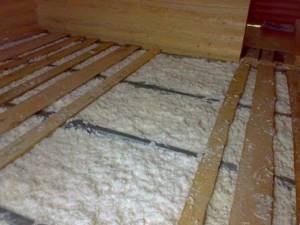
Each of them has its own advantages, and in most cases the choice depends on the availability of a particular material and the personal preferences of the homeowner. The thickness of the heat insulator depends on the climate in which the wooden house is located, on its location in relation to the ground level, as well as on the manufacturer’s recommendations.
Thermoplastics
Polystyrene foam and penoplex are very similar materials. They are produced by foaming plastic masses, sometimes introducing additional additives that prevent decomposition and make them unattractive to rodents. Both of these materials have a very low thermal conductivity.

Note! For comparison: in terms of thermal efficiency, 5 cm thick foam is equivalent to 75 cm thick brickwork.
It is convenient to use such materials, as they are produced in the form of sheets of various thicknesses. Transporting them to the construction site is not a hassle. They are very light and durable. You can cut polystyrene foam or penoplex with a regular stationery knife. When insulating the surface, they can be used to seal the resulting gaps at the joints with ordinary polyurethane foam. Adhesion with insulation is very good.

Polyurethane foam is a material that is more commonly seen in everyday life as foam mats. Such mats are not used in construction, and polyurethane foam is applied to the surface by spraying. Later, during the process of hardening and polymerization, it foams and hardens. As a result, polyurethane foam forms a durable, waterproof, airtight, warm coat for building structures.
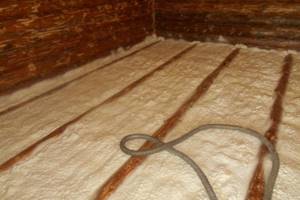
Mineral wool
Various construction wools have been used as insulation for a very long time. Currently, glass wool, mineral or basalt wool are most often used.
In appearance and production technology, they are very similar to each other, differing from each other only in the raw materials used. To obtain them, raw materials are heated, melted using special equipment, and then drawn into threads. Later, when these fibers harden, looms that vaguely resemble weaving machines knit a bulky mass of low density from them.
Such insulation is produced in the form of rectangular mats of various thicknesses or in the form of rolls.
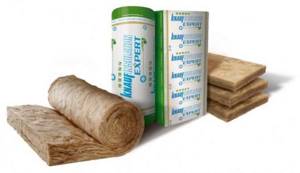
Penofol
Penofol refers to thin plates or sheets of polyethylene foam. Their thickness can be from 3 mm to 10 mm. In terms of thermal insulation qualities, this material is comparable to foam plastic or penoplex, but it is more convenient to work with due to the fact that it is flexible. Penofol is produced and supplied for sale and to construction sites in rolls 0.5 meters and 1 meter wide.
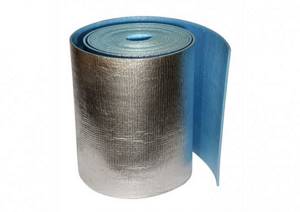
The insulation is produced in three versions - foil on one side, on both sides, or foil on one side and with an adhesive layer applied on the other. The latter option is most preferable to use, since installation of such insulation takes very little time. It is enough to cut out the required blank from the sheet and, having separated the protective film from the adhesive layer, apply it to the wooden surface and press briefly.
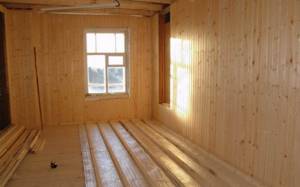
Sawdust
Sawdust has traditionally been used as insulation, since it was a by-product of any sawmill production, and its origin has always accompanied the production of lumber. For a very long time, sawdust was used to insulate wooden floors, falling asleep in layers between the joists.
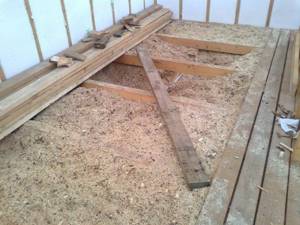
A mass of sawdust, if it is not subject to getting wet, can lie in a closed space for years without caking. At the same time, the low density of such insulation is maintained, which provides excellent thermal insulation properties. The disadvantage of such insulation is that the sawdust cakes very quickly and even begins to rot, as soon as you wet them a little. To prevent rotting of sawdust and damage by various wood borers, they are treated with a solution of potassium permanganate or the sawdust is mixed with lime.
When insulation is required from below
There are several main reasons why a wooden house is thermally insulated from below. These include:
When is floor insulation required in a home?
- the need to reduce the height of the room;
- protection of the floor and the entire covering from freezing;
- moving the dew point, thereby avoiding the process of rotting.

Insulation of floors protects the house from freezing
During renovation work in a private house, some difficulties often arise that are directly related to the insulation of the bottom. Let's look at the most common of them:
- more reliable fixation of the heat-insulating material is required;
- the presence of a low subfloor greatly complicates the work;
- insulation of the floor from below contributes to rapid fatigue of workers, which greatly delays the process;
- The variety of types of insulation is not very large.
How and with what you can insulate the floor in a private house
Floor insulation is a rather complex process that requires preparation. First of all, before starting repair work, you need to decide on the choice of insulation.
How can you insulate the floor in a private house and what materials should you use?
Vapor barrier of the floor in a wooden house
Materials used as insulation for floor joists
*
Traditional materials that serve as floor insulation on floor joists until recently included slag resulting from the combustion of coal and ordinary furnace ash. This material was characterized by low efficiency, as well as the need for careful sealing of the places where they were used due to the ability to form fine dust that leaked into literally any crack.
Now the material that provides floor insulation between installed joists with various properties and scope of application can be selected in any required option. Such insulation materials for laying thermal insulation material include:
- Expanded clay, which can be used both in bulk (like slag and ash) and in the form of expanded clay concrete screed, for example, in reinforced concrete floors. Expanded clay is fine crushed limestone shale fired to the point of swelling. Typically, fractions of granules with a diameter of 2 to 7 centimeters are used for these purposes.

Main article: how to insulate a floor with sawdust.
- Styrene board foam. With all its excellent qualities of heat and noise protection, when heated (for example, in the event of a fire), this material begins to release volatile substances that are very harmful to human breathing.
- Polyurethane foam, applied in liquid form, then increasing several times in volume, curing due to the humidity of the surrounding air. Such foam is obtained by using standard cylinders purchased in construction stores, or by mixing two or more components (polyurethane resin and foaming agents).
- Foam or aerated concrete, which is produced by introducing aluminum powder into a cement-sand solution, which reacts with cement and acts like yeast in dough. It is used instead of expanded clay concrete according to the same technological scheme.
- Mineral (stone, glass) wool. Available in the form of flat slabs or mats rolled into rolls. This thermal insulation is cut into pieces of the required size, so that it fits tightly between the beams and joists. Fixed with glue, screws, strips of metal and plastic. The material is environmentally friendly. In case of fire, it remains neutral to high temperatures and does not lose its shape. In terms of price/quality/environmental safety ratio, mineral, basalt or glass wool should be recognized as the best material used as thermal insulation.
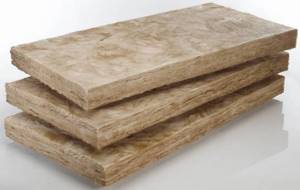
Rarely used materials for thermal insulation:
- The bark of balsa wood is pressed into slabs.
- Foamed polyethylene (polypropylene). Sometimes covered with aluminum foil on one side (see the necessary instructions for using such insulation when purchasing it).
- Expanded perlite sand (sometimes another mineral with similar properties, vermiculite, is used instead of perlite). It is packaged in paper bags; the weight of one of them is, depending on the volumetric weight of the sand, from 2 to 5 kg. The voids in the ceiling are filled with bags along with insulation. This is facilitated by the fact that the bags are filled no more than half when packed.
Optimal insulation for wooden floors
There is no point in discussing the best material for thermal insulation of a wooden floor. Almost everything is applicable, from grandfather’s dry leaves to expensive vermiculite. Floors in wooden houses are insulated using loose thermal insulation options, mats and slabs.
Since the list of requirements for any insulation consistently includes lightness, minimal water permeability, durability, and operational safety, all these qualities are quite satisfactory for builders and owners of wooden houses.
The choice mainly depends on the financial capabilities of the owner, the type of base and the method of installation. Owners who are not limited in funds will be able to purchase progressive, easy-to-install materials with detailed instructions on how to insulate the floor in a private house without the involvement of builders and with an accurate indication of the thermal properties of the factory product on the packaging. If you want to save money, you will have to tinker a lot with traditional insulation schemes.

Insulation for thrifty owners
Independent home craftsmen who do not want or do not have the opportunity to invest significant sums in insulation can use the following as a heat insulator:
- dry sawdust, which pleases with a minimal price, but requires reliable waterproofing on both sides of the insulating layer due to the tendency of the material to actively absorb moisture;
- sawdust granules, which are a more practical option, treated with an antiseptic and fire retardant;
- slag, which attracts cost, but is used primarily in floor insulation schemes on the ground;
- expanded clay, used to create a heat-insulating layer of considerable thickness, since its optimal thickness for our latitudes is considered to be 30 cm;
- simple mineral wool without foil and corrugated shells that increase thermal performance;
- roll insulation, created on the basis of glass fibers, slag wool;
- polystyrene foam, which requires measures to protect it from the encroachment of rodents and from fires.
If you follow the rules for installing thermal insulation using the listed materials, heat leakage through the lower ceiling will be eliminated. However, laying them will require impressive labor efforts.

Modernized, expensive insulation materials
If the owner of a country property does not have the main task of how to insulate the floor in a wooden house at low cost, then he has at his disposal:
- Vermiculite is a product of processing hydrated mica, which has excellent insulating qualities and long service life;
- Penoplex is extruded polystyrene foam produced in slab format with increased strength and excellent waterproofing properties;
- Various modifications of insulation with the brands Ursa, Thermolife, Isovent, Penofol, Izolyte, etc., which are mats and slabs with bases made of foamed polystyrene, glass wool and a basalt analogue, optimized by increasing wear resistance, minimizing water permeability, applying foil shells to reflect back heat rays and other methods.
In case of minor heat leaks, you can insulate a wooden floor with ecowool or polyurethane foam, but without special equipment it is impossible to blow in these materials.
This is a significant disadvantage, but the advantage is the creation of a dense water-repellent insulation layer that does not require a device to protect the insulation from steam.
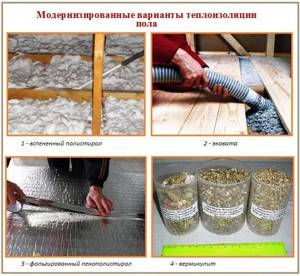
The easiest way
A simple way to insulate is to use linoleum and carpet to cover wooden floors. For this purpose, a special type of linoleum is purchased, the lower part of which contains a heat-insulating layer. By the way, such coatings are not at all uncommon, since the market reacts sharply to the diverse demands of consumers.
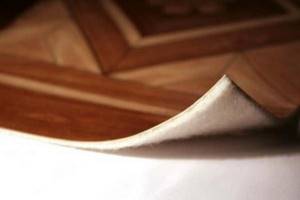
The appearance of such materials is due to the complexity of insulation along joists: this method is not available to everyone, since in this case it is possible to properly insulate a wooden floor only using special tools. But any modern owner of a private house or cottage can afford linoleum.
The essence of the process
The entire insulation process with this approach comes down to laying linoleum rolls, which are then covered with carpet. Carpet is a special covering for floors, the operation of which does not involve heavy contamination, since the material is very similar to carpets and it gets dirty accordingly. It is well suited for a private home or for insulating the floor on the first floor of an apartment building, but is inconvenient for a summer residence.
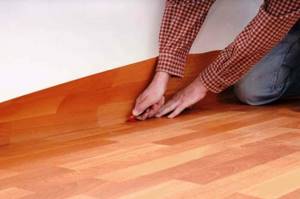
The main advantage of carpet is that it can be installed over the entire floor area, unlike carpets that are limited in size. The carpet is supplied in rolls and laid as convenient for the owner of the room.
As a result, the linoleum is protected from the bottom by a heat-insulating substrate. The top is covered with carpet, which also has good heat-protective qualities. For insignificant heat losses, this is a fairly effective solution.
Wall insulation with Izolon
It is important to lay the sheets end to end and seal the gaps. As we have already found out, ordinary polyethylene foam does not provide the expected reduction in heat loss, so insulation of walls with Izolon from the inside must be carried out with foil materials
The shiny surface will send heat rays back into the room. If the foil is glued to a polyethylene base, then the ability to absorb sounds and vibration, as well as retain water and steam, is added to the reflective properties. All this is necessary when you need to insulate a bathhouse, or rather a steam room
As we have already found out, ordinary polyethylene foam does not provide the expected reduction in heat loss, so insulating walls with Izolon from the inside must be done with foil materials. The shiny surface will send heat rays back into the room. If the foil is glued to a polyethylene base, then the ability to absorb sounds and vibration, as well as retain water and steam, is added to the reflective properties. All this is necessary when you need to insulate a bathhouse, or rather a steam room.
Let's consider installation methods with additional insulation with mineral wool:
- We attach wooden blocks to the wall - in any order, the main thing is that later it will be convenient to stuff the counter-lattice;
- Mineral wool is placed randomly between the bars; you don’t even have to glue it to the wall;
- on top of the bars, Izolon insulation, foil-coated with the shiny side, is nailed into the middle of the room with a stapler;
- the rolls are spread end-to-end, and the cracks are sealed with aluminum-coated tape;
- the second tier of the lathing is nailed (counter-lattice);
- Any finish can be attached.
This is necessary so that the material can realize its 100% potential. After all, the foil reflects IR rays, and they are transmitted only through the air; if there is no gap, then radiation is impossible in this case. Temperature will transfer from one material to another, and aluminum conducts heat very well. Therefore, instead of insulation, you can get the opposite result.
How does floor insulation under screed differ from the rest?
If screed will be poured in the room, you must follow the technology when carrying out the work
There is nothing complicated in the process, but you need to do everything according to the instructions and not miss a single important point:
- Prepare the base: if it is a wooden flooring, you need to cover it with waterproofing film. Level other surfaces; if they are in poor condition, pour a continuous rough screed or apply it in places where it is required.
- Lay extruded polystyrene foam or polystyrene foam with a density of 35 kg per cubic meter. It should be laid in such a way that there are no gaps; in this regard, extruded slabs with grooves are more convenient, they are much easier to join. The cracks near the walls can be filled with mounting foam so that there are no significant voids.
- A vapor barrier material is laid on top, overlapping the walls, so that there is room for pouring the screed. The joints are taped; there should be no breaks.
- To strengthen the floor and distribute the load evenly, lay a mesh with a 5x5 cm cell. It simply unwinds and lays out in rows; you don’t have to connect them, but tie them with a special wire.
- Fill the screed as usual; there is no difference from the situation when the floor is made without a heat-insulating layer.
If you make a floor directly on the ground, you need to make a pillow. First, pour 10 cm of crushed stone and level it, and then make a layer of sand 5 to 10 cm thick, then moisten it well and compact it manually or using a machine.
Advice from professionals
When insulating the floor of a wooden house, it is recommended to follow the advice of professionals:
- It is good to treat wood with antiseptics.
- Insulate the heat insulator from moisture from the floor and from the room.
- Use a building level when installing wooden joists. The floor after insulation must be level, otherwise the work will be difficult to redo.
- There should be a small air gap between the surface of the clean floor and the insulation, which will help prevent the formation of mold. Therefore, the thickness of the installed logs should be higher than the insulation.
To visually familiarize yourself with the insulation process, you can watch the video instructions. All stages of the work are described.
To insulate a wooden floor you do not need a special set of tools. It is enough to purchase materials for insulation, as well as carry out the installation correctly. Insulating the floor from above is simpler, but from below will require more effort. But the latter option will not take away precious centimeters of room height.
Classic scheme
A feature of the classic scheme is the significant distance between the beams.
Typically, the layout step is 0.8-1 m, and this is “reflected” in the choice of board thickness.
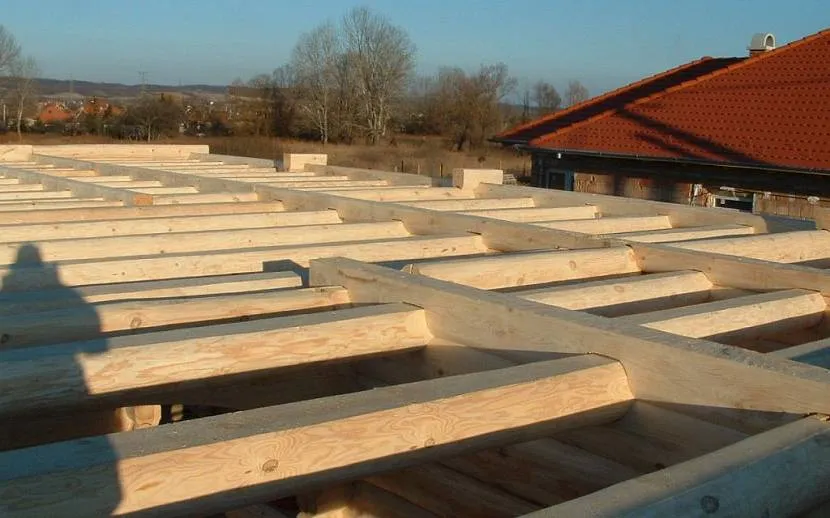
This is what a “powerful” log house floor looks like Source ukrasheniyedoma.com
A typical subfloor structure looks like this:
- timber with a section of 15x15 or 15x20 cm;
- cranial block with a cross section of 4x4 cm;
- hemming with a board 2.0 cm thick (can be unedged, but cleared of wane) or plywood 1.5 cm thick;
- waterproofing (glassine, polymer membrane);
- insulation (stone wool) no more than 10 cm thick - this is all that the remaining volume between the beams allows after installing the cranial block with filing;
- vapor barrier;
- board 4.5-5.0 cm thick.
And now this design is used, but it no longer meets modern requirements for thermal protection. Therefore, a counter-lattice is mounted on top of the beams, between which another layer of thermal insulation is laid.
Another advantage of this method is that the layout of the logs can be reduced to 30-40 cm, and subfloor boards can be chosen with a thickness of 20-24 mm.

Scheme of complex insulation of a frame house with a double thermal insulation contour of the floor and mesh as a backing Source obustroeno.com
The modern scheme for laying a subfloor for a wooden house is more advanced and allows you to insulate the floor without additional “superstructures” in the form of a counter-lattice:
- Boards placed on edge . Fixed to the beam, and, if necessary, supported by intermediate supports, they act as logs. The thickness of the board is 5 cm, and the width is at least 20 cm. The layout step can be made 60 cm (to match the width of the stone wool rolls), and in terms of wood consumption for purlins, this option is more economical than the classic scheme.
- Polymer (wire mesh) for supporting waterproofing and insulation.
- wind and waterproofing film . Allows excess moisture to evaporate, protects the insulation from water ingress and weathering of fibers.
- Stone wool in the form of semi-rigid mats 20 cm thick.
- Vapor barrier.
- Flooring made of boards 36 mm thick.
The only drawback of the modern scheme is the poor stability of the lag. This is due to the large difference between the width (the supporting part) and the height. To ensure the stability of the structure, additional transverse braces are used that “connect” the logs to each other and to the frame (grillage).
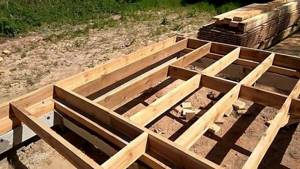
Typical ceiling of the first floor of a frame house made of boards on the “edge” Source stranapap.ru
The advantages of the scheme are obvious - savings on lumber (in “volume” equivalent) and a simple one-layer insulation scheme.
New generation insulation materials
Penofol is a modern cool insulation material that has not become widely used exclusively in its “youth” years. The option is presented in the form of a layer with fused polished foil. The well-known reflective ability of foil is enhanced by its high thermal insulation properties.
Available in various modifications with other materials. The base is built on foamed polyethylene technology, which is responsible for water resistance and, thus, eliminates the need for a vapor barrier layer.
Polyurethane foam
- technological synthesis of isocyantic and polyol components, indicated by a cellular structure, with pores filled with gas and air. Therefore, it is lightweight and has a low degree of thermal conductivity, resists rotting and the development of mold spores, and also does not react to the effects of alkalis and acids.
Ecowool
- a type of insulation consisting of 80% waste paper and cellulose fibers. The binding link is boric acid, and lignin is used as an antiseptic. Despite the paper content, the material resists fire and is only capable of smoldering.
Nuances
Concrete, which has already been mentioned more than once, is a necessary basis for a wooden floor. The fact is that “floors” most often mean the final coating with which the interaction directly occurs. So, a parquet floor is also wooden, but parquet boards can lie on concrete, that is, a base.
If we consider the floor in global terms, it is a rather complex system consisting of many sections. Wood in this case is the last “layer”, a finish that cannot be insulated by itself - all activities are carried out on its base, from below.
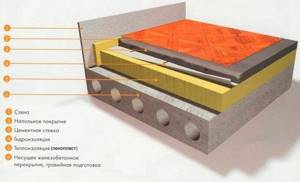
All insulation work on wooden floors is carried out precisely on the base area, the “subfloor”. The finished insulation systems are covered on top with some material, one of which is wood. When they talk about the thermal protection of wooden floors, they mean different floorings that are not visible behind the final floor covering.
Creating an insulating layer on top of the rough layer, as a rule, involves laying polyethylene - it provides excellent protection against changes in humidity and is low cost.
Features and Benefits
If a wooden house has an underground or basement room, the insulation process should begin from there: as a result of cold air coming up from the freezing ground, a large loss of heat occurs. Also, before insulation, it is necessary to ensure complete drying of the entire room where the work will be carried out, using special ventilation devices.
The installation of thermal insulation coatings itself is not particularly difficult. The main thing is that the materials are of proper quality and treated with special means: this will help reduce the impact on them of the weight of the boards, soil and low temperatures. Before purchasing insulating coatings, you should consider what the load on them will be, as well as the level of the lowest temperature indicator that a particular type of material can adequately withstand.
But in general, any insulation technology has several main stages:
- First, the logs are installed, then dense sheets of wood are fixed on them, and only after that the installation of the insulation itself begins.
- After the insulation is laid, the base is sheathed with a material that has the property of insulating from steam and moisture: this ensures that the material will retain its original properties longer.
- At the end of the work, the rough base is refined using finishing.
Insulating an old floor
After dismantling the old floor, check the safety of the joists. If defects, damage (cracks, rotting) and vibration due to mechanical stress are detected, they are replaced. The work is similar to roofing. The big disadvantage will be the duration, since you will have to knock out the joists from the concrete.
Next, new logs with the same cross-section as the previous ones are installed. The horizontal level can be checked with a stretched fishing line. The logs are pre-treated with an antiseptic, and the seats are treated with resin.
Again, check the level and fill with concrete. It is important to secure the ends into the mounting sockets using dry gravel. They do not move to a new stage until the concrete has completely hardened.
Subfloor boards are not mounted directly on the joists. The sheathing is installed with small beams, and then boards are placed on them. Nails should not penetrate the thickness of the joist. Experts have different opinions about antiseptic treatment at this stage. But insurance against mold and fungi will not be superfluous, although it will require time and financial costs. There should be no differences in the rough field.
Membranes will help ensure proper waterproofing. It is mounted on the subfloor with the walls reaching the height of the finished floor.
Logs made of 150x50 mm timber are fixed in increments of 100 cm. When installing heavy furniture, the size is increased to 75x150 mm. The gap between the finishing joists and the wall is filled with insulation.
The heat insulator is laid on a waterproofing membrane. A gap of 3 cm is provided to the level of the finished floor for ventilation. A vapor barrier layer is mounted on the insulation.
The finishing coating is secured with screws or nails. If they are in good condition, you can use old boards.
Summing up
When choosing a suitable insulation for the floor, it is necessary to take into account not only the technical characteristics, but also the conditions of its future operation. This is the only way you can choose the best option.
Therefore, thermal insulation material is always selected individually. But if you have 2 insulation materials with similar characteristics, then always choose the one produced by a well-known manufacturer. Then the likelihood that the material will serve without problems for many years will increase significantly!
Types of floor
In houses made of wood, two types of floors are used: concrete and wood.
The second option is divided into two categories:
- floor boards, laminated wood;
- parquet board and laminate.
You can make a concrete floor yourself without involving specialists. There are two options for laying concrete: on the ground and on logs. The most common is the first option.
All work is carried out in several stages:
- priming;
- sand;
- thermal insulation;
- waterproofing.
The next step is to fill the floor with concrete screed. If a warm floor is installed, then it must be installed at this stage.
A wooden floor, like a concrete floor, also has several layers:
- bulk floor (rough);
- waterproofing layer;
- thermal insulation layer;
- fine coating.
About the insulation thickness
The best way to maintain a safe temperature gradient in the floor is to stretch it in height. Therefore, floor insulation should be made as thick as possible. If the height of the room and thresholds, taking into account the finished flooring, allow you to install insulation of 12 cm or more - excellent, there will be no problems. To increase the thickness of the insulation, it is better to increase the thickness of the bedding, and make the thickness of the concrete layer normal. Otherwise, a cushion of fibrous aluminized insulation should be provided under the finished floor; as a last resort - from cheaper mineral wool with the most scrupulous adherence to technology.

